Qualitative Changes in Global Economy due to Globalization
VerifiedAdded on 2022/12/29
|8
|2155
|30
AI Summary
This report explores the qualitative changes in the global economy due to globalization, including political, technological, economic, financial, and trade interdependence factors.
Contribute Materials
Your contribution can guide someone’s learning journey. Share your
documents today.
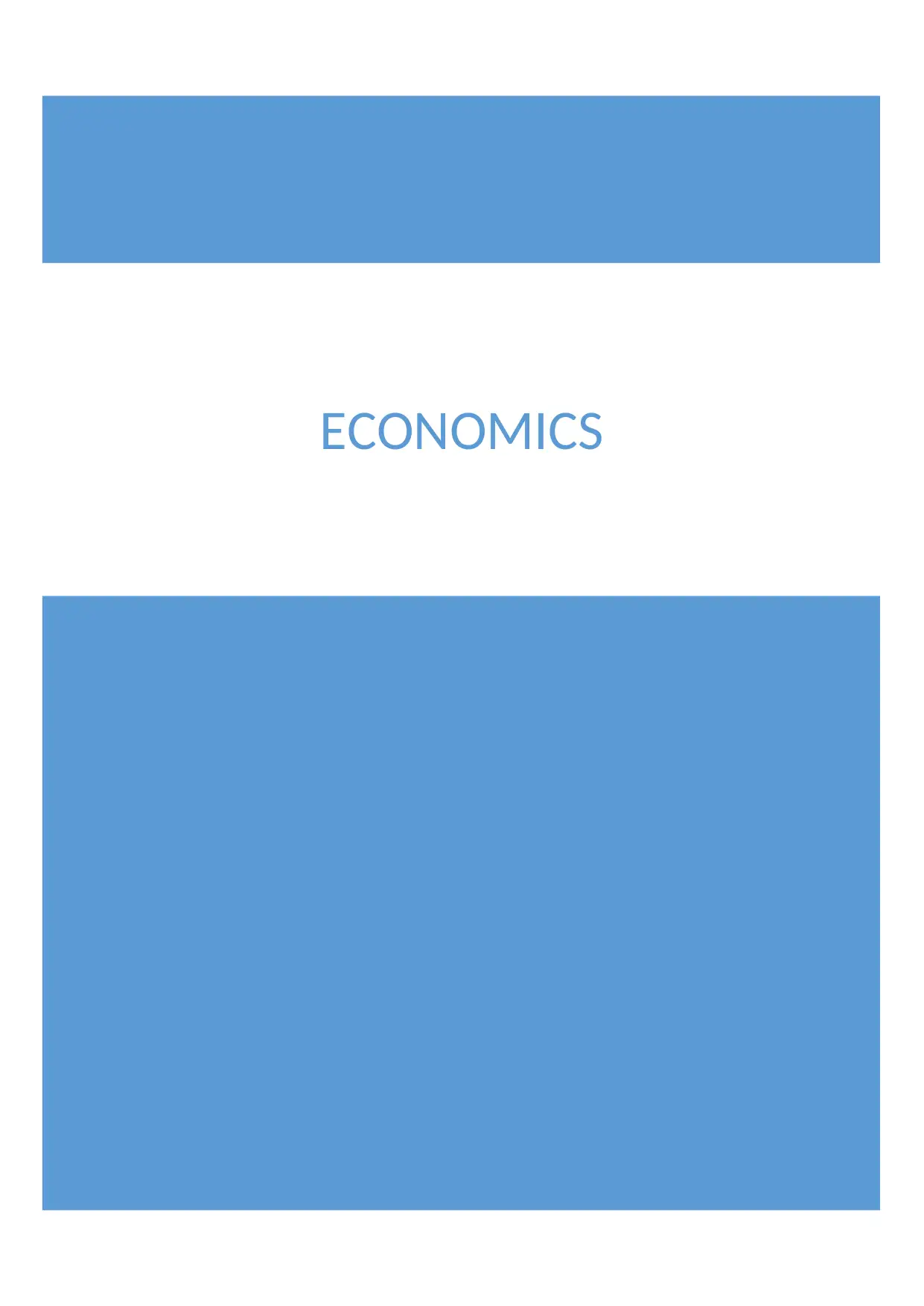
ECONOMICS
Secure Best Marks with AI Grader
Need help grading? Try our AI Grader for instant feedback on your assignments.
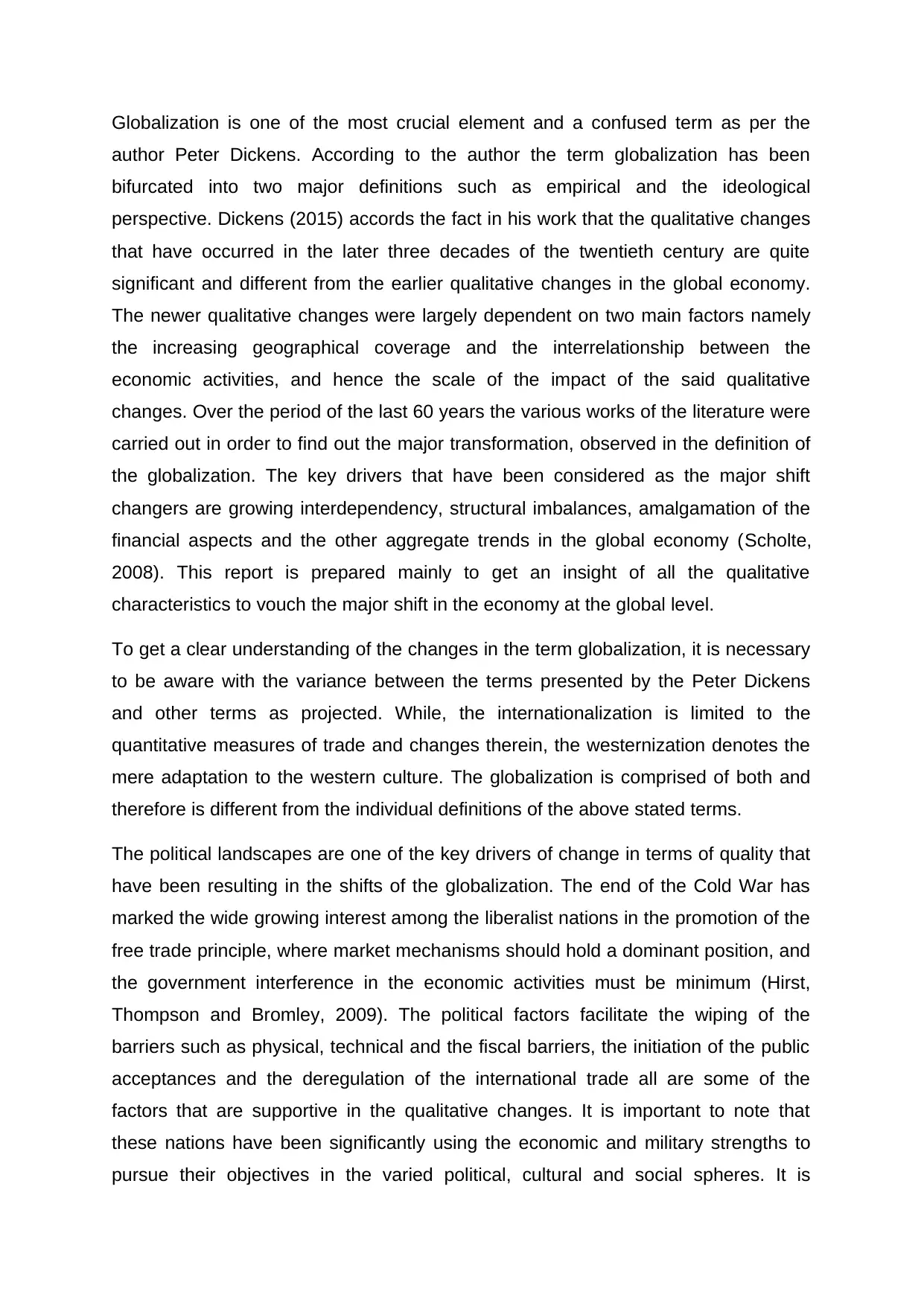
Globalization is one of the most crucial element and a confused term as per the
author Peter Dickens. According to the author the term globalization has been
bifurcated into two major definitions such as empirical and the ideological
perspective. Dickens (2015) accords the fact in his work that the qualitative changes
that have occurred in the later three decades of the twentieth century are quite
significant and different from the earlier qualitative changes in the global economy.
The newer qualitative changes were largely dependent on two main factors namely
the increasing geographical coverage and the interrelationship between the
economic activities, and hence the scale of the impact of the said qualitative
changes. Over the period of the last 60 years the various works of the literature were
carried out in order to find out the major transformation, observed in the definition of
the globalization. The key drivers that have been considered as the major shift
changers are growing interdependency, structural imbalances, amalgamation of the
financial aspects and the other aggregate trends in the global economy (Scholte,
2008). This report is prepared mainly to get an insight of all the qualitative
characteristics to vouch the major shift in the economy at the global level.
To get a clear understanding of the changes in the term globalization, it is necessary
to be aware with the variance between the terms presented by the Peter Dickens
and other terms as projected. While, the internationalization is limited to the
quantitative measures of trade and changes therein, the westernization denotes the
mere adaptation to the western culture. The globalization is comprised of both and
therefore is different from the individual definitions of the above stated terms.
The political landscapes are one of the key drivers of change in terms of quality that
have been resulting in the shifts of the globalization. The end of the Cold War has
marked the wide growing interest among the liberalist nations in the promotion of the
free trade principle, where market mechanisms should hold a dominant position, and
the government interference in the economic activities must be minimum (Hirst,
Thompson and Bromley, 2009). The political factors facilitate the wiping of the
barriers such as physical, technical and the fiscal barriers, the initiation of the public
acceptances and the deregulation of the international trade all are some of the
factors that are supportive in the qualitative changes. It is important to note that
these nations have been significantly using the economic and military strengths to
pursue their objectives in the varied political, cultural and social spheres. It is
author Peter Dickens. According to the author the term globalization has been
bifurcated into two major definitions such as empirical and the ideological
perspective. Dickens (2015) accords the fact in his work that the qualitative changes
that have occurred in the later three decades of the twentieth century are quite
significant and different from the earlier qualitative changes in the global economy.
The newer qualitative changes were largely dependent on two main factors namely
the increasing geographical coverage and the interrelationship between the
economic activities, and hence the scale of the impact of the said qualitative
changes. Over the period of the last 60 years the various works of the literature were
carried out in order to find out the major transformation, observed in the definition of
the globalization. The key drivers that have been considered as the major shift
changers are growing interdependency, structural imbalances, amalgamation of the
financial aspects and the other aggregate trends in the global economy (Scholte,
2008). This report is prepared mainly to get an insight of all the qualitative
characteristics to vouch the major shift in the economy at the global level.
To get a clear understanding of the changes in the term globalization, it is necessary
to be aware with the variance between the terms presented by the Peter Dickens
and other terms as projected. While, the internationalization is limited to the
quantitative measures of trade and changes therein, the westernization denotes the
mere adaptation to the western culture. The globalization is comprised of both and
therefore is different from the individual definitions of the above stated terms.
The political landscapes are one of the key drivers of change in terms of quality that
have been resulting in the shifts of the globalization. The end of the Cold War has
marked the wide growing interest among the liberalist nations in the promotion of the
free trade principle, where market mechanisms should hold a dominant position, and
the government interference in the economic activities must be minimum (Hirst,
Thompson and Bromley, 2009). The political factors facilitate the wiping of the
barriers such as physical, technical and the fiscal barriers, the initiation of the public
acceptances and the deregulation of the international trade all are some of the
factors that are supportive in the qualitative changes. It is important to note that
these nations have been significantly using the economic and military strengths to
pursue their objectives in the varied political, cultural and social spheres. It is
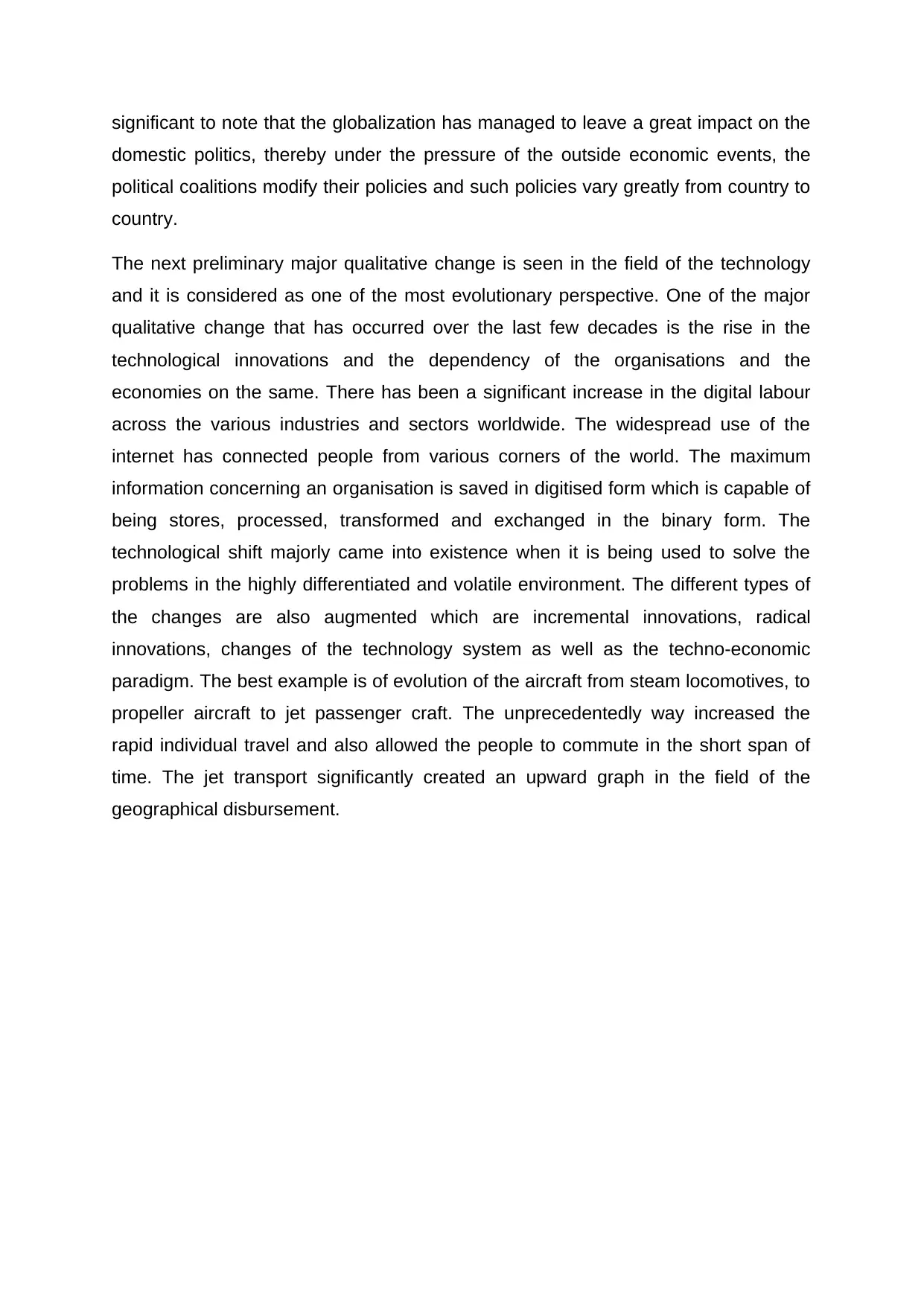
significant to note that the globalization has managed to leave a great impact on the
domestic politics, thereby under the pressure of the outside economic events, the
political coalitions modify their policies and such policies vary greatly from country to
country.
The next preliminary major qualitative change is seen in the field of the technology
and it is considered as one of the most evolutionary perspective. One of the major
qualitative change that has occurred over the last few decades is the rise in the
technological innovations and the dependency of the organisations and the
economies on the same. There has been a significant increase in the digital labour
across the various industries and sectors worldwide. The widespread use of the
internet has connected people from various corners of the world. The maximum
information concerning an organisation is saved in digitised form which is capable of
being stores, processed, transformed and exchanged in the binary form. The
technological shift majorly came into existence when it is being used to solve the
problems in the highly differentiated and volatile environment. The different types of
the changes are also augmented which are incremental innovations, radical
innovations, changes of the technology system as well as the techno-economic
paradigm. The best example is of evolution of the aircraft from steam locomotives, to
propeller aircraft to jet passenger craft. The unprecedentedly way increased the
rapid individual travel and also allowed the people to commute in the short span of
time. The jet transport significantly created an upward graph in the field of the
geographical disbursement.
domestic politics, thereby under the pressure of the outside economic events, the
political coalitions modify their policies and such policies vary greatly from country to
country.
The next preliminary major qualitative change is seen in the field of the technology
and it is considered as one of the most evolutionary perspective. One of the major
qualitative change that has occurred over the last few decades is the rise in the
technological innovations and the dependency of the organisations and the
economies on the same. There has been a significant increase in the digital labour
across the various industries and sectors worldwide. The widespread use of the
internet has connected people from various corners of the world. The maximum
information concerning an organisation is saved in digitised form which is capable of
being stores, processed, transformed and exchanged in the binary form. The
technological shift majorly came into existence when it is being used to solve the
problems in the highly differentiated and volatile environment. The different types of
the changes are also augmented which are incremental innovations, radical
innovations, changes of the technology system as well as the techno-economic
paradigm. The best example is of evolution of the aircraft from steam locomotives, to
propeller aircraft to jet passenger craft. The unprecedentedly way increased the
rapid individual travel and also allowed the people to commute in the short span of
time. The jet transport significantly created an upward graph in the field of the
geographical disbursement.
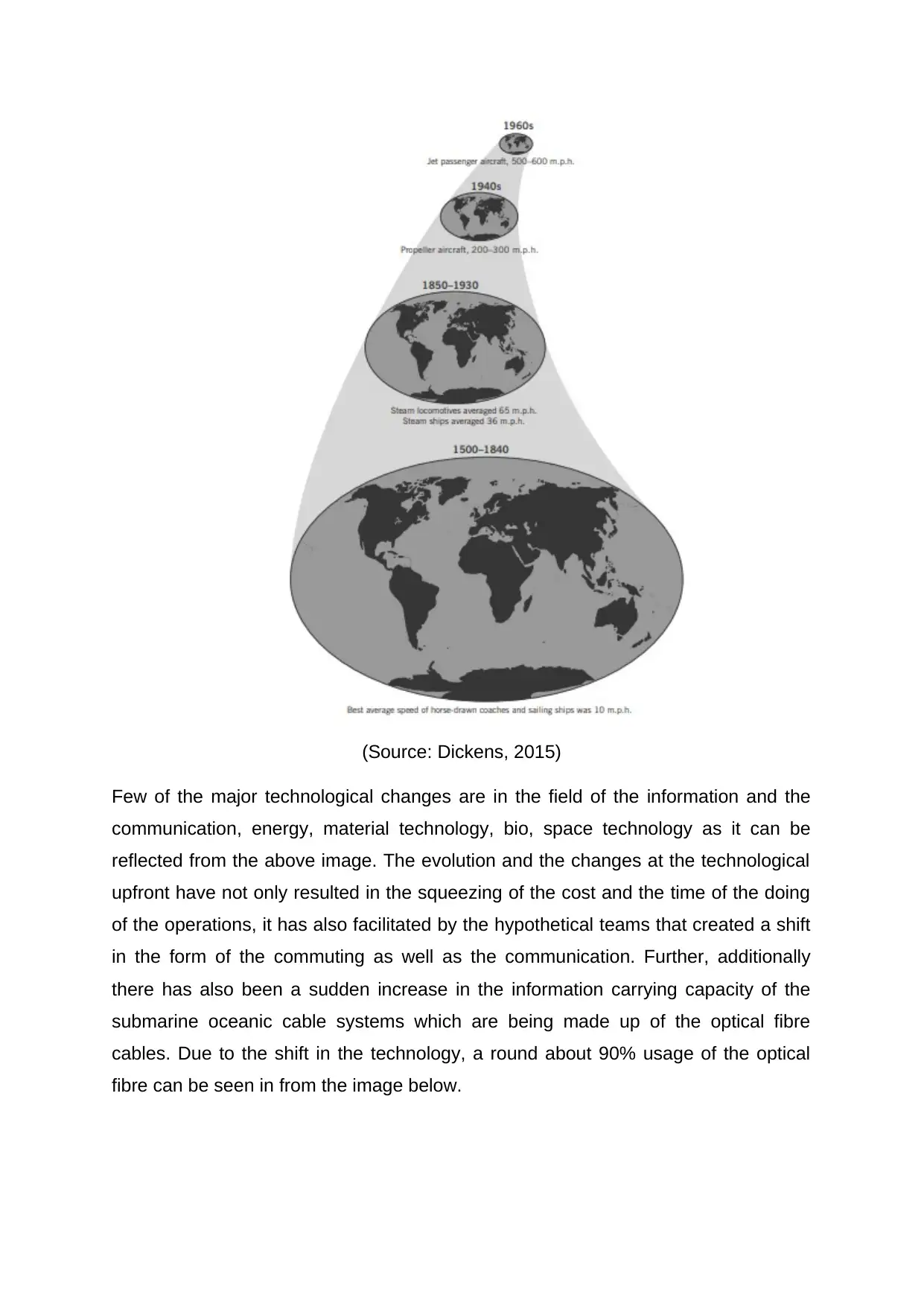
(Source: Dickens, 2015)
Few of the major technological changes are in the field of the information and the
communication, energy, material technology, bio, space technology as it can be
reflected from the above image. The evolution and the changes at the technological
upfront have not only resulted in the squeezing of the cost and the time of the doing
of the operations, it has also facilitated by the hypothetical teams that created a shift
in the form of the commuting as well as the communication. Further, additionally
there has also been a sudden increase in the information carrying capacity of the
submarine oceanic cable systems which are being made up of the optical fibre
cables. Due to the shift in the technology, a round about 90% usage of the optical
fibre can be seen in from the image below.
Few of the major technological changes are in the field of the information and the
communication, energy, material technology, bio, space technology as it can be
reflected from the above image. The evolution and the changes at the technological
upfront have not only resulted in the squeezing of the cost and the time of the doing
of the operations, it has also facilitated by the hypothetical teams that created a shift
in the form of the commuting as well as the communication. Further, additionally
there has also been a sudden increase in the information carrying capacity of the
submarine oceanic cable systems which are being made up of the optical fibre
cables. Due to the shift in the technology, a round about 90% usage of the optical
fibre can be seen in from the image below.
Secure Best Marks with AI Grader
Need help grading? Try our AI Grader for instant feedback on your assignments.
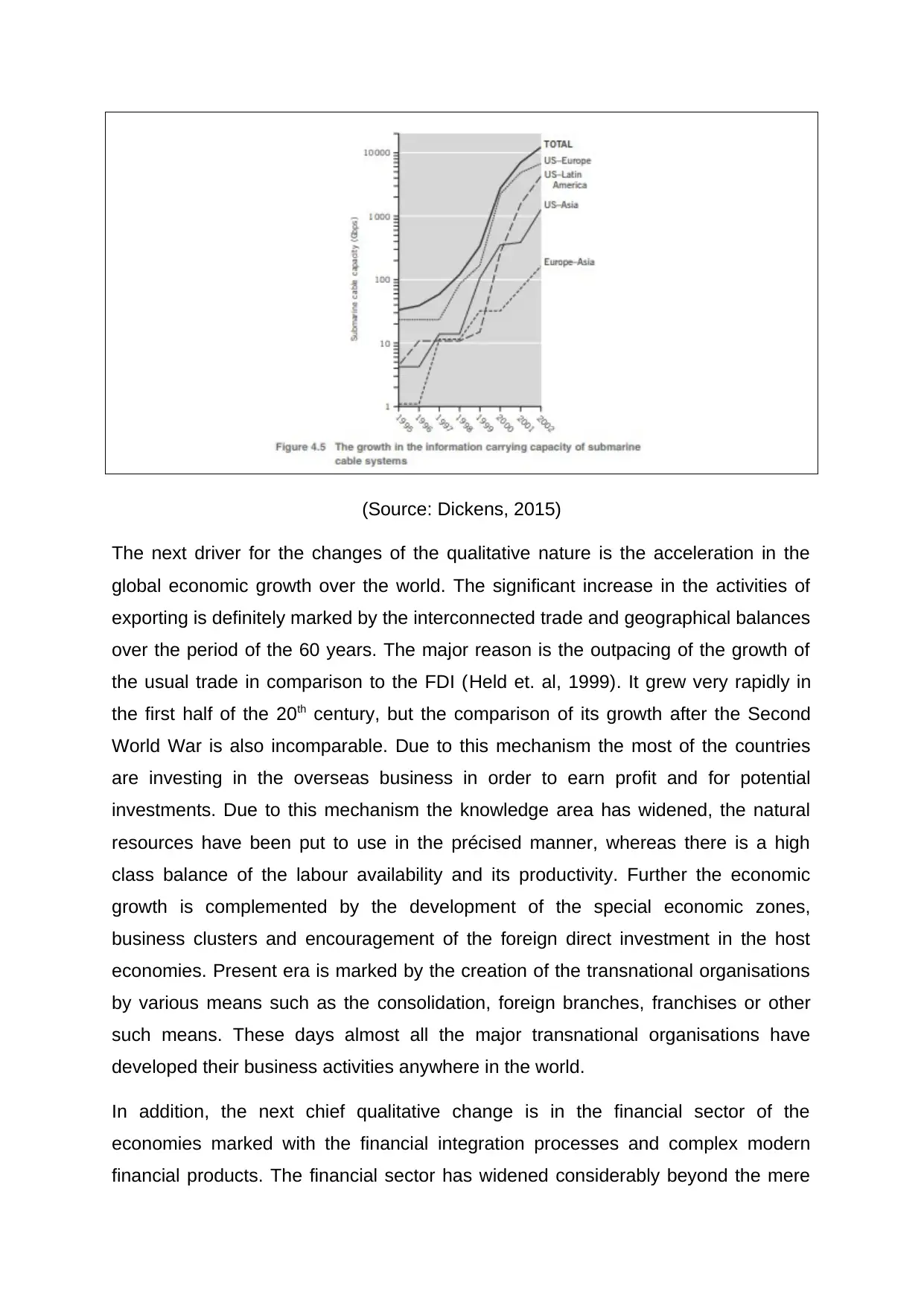
(Source: Dickens, 2015)
The next driver for the changes of the qualitative nature is the acceleration in the
global economic growth over the world. The significant increase in the activities of
exporting is definitely marked by the interconnected trade and geographical balances
over the period of the 60 years. The major reason is the outpacing of the growth of
the usual trade in comparison to the FDI (Held et. al, 1999). It grew very rapidly in
the first half of the 20th century, but the comparison of its growth after the Second
World War is also incomparable. Due to this mechanism the most of the countries
are investing in the overseas business in order to earn profit and for potential
investments. Due to this mechanism the knowledge area has widened, the natural
resources have been put to use in the précised manner, whereas there is a high
class balance of the labour availability and its productivity. Further the economic
growth is complemented by the development of the special economic zones,
business clusters and encouragement of the foreign direct investment in the host
economies. Present era is marked by the creation of the transnational organisations
by various means such as the consolidation, foreign branches, franchises or other
such means. These days almost all the major transnational organisations have
developed their business activities anywhere in the world.
In addition, the next chief qualitative change is in the financial sector of the
economies marked with the financial integration processes and complex modern
financial products. The financial sector has widened considerably beyond the mere
The next driver for the changes of the qualitative nature is the acceleration in the
global economic growth over the world. The significant increase in the activities of
exporting is definitely marked by the interconnected trade and geographical balances
over the period of the 60 years. The major reason is the outpacing of the growth of
the usual trade in comparison to the FDI (Held et. al, 1999). It grew very rapidly in
the first half of the 20th century, but the comparison of its growth after the Second
World War is also incomparable. Due to this mechanism the most of the countries
are investing in the overseas business in order to earn profit and for potential
investments. Due to this mechanism the knowledge area has widened, the natural
resources have been put to use in the précised manner, whereas there is a high
class balance of the labour availability and its productivity. Further the economic
growth is complemented by the development of the special economic zones,
business clusters and encouragement of the foreign direct investment in the host
economies. Present era is marked by the creation of the transnational organisations
by various means such as the consolidation, foreign branches, franchises or other
such means. These days almost all the major transnational organisations have
developed their business activities anywhere in the world.
In addition, the next chief qualitative change is in the financial sector of the
economies marked with the financial integration processes and complex modern
financial products. The financial sector has widened considerably beyond the mere
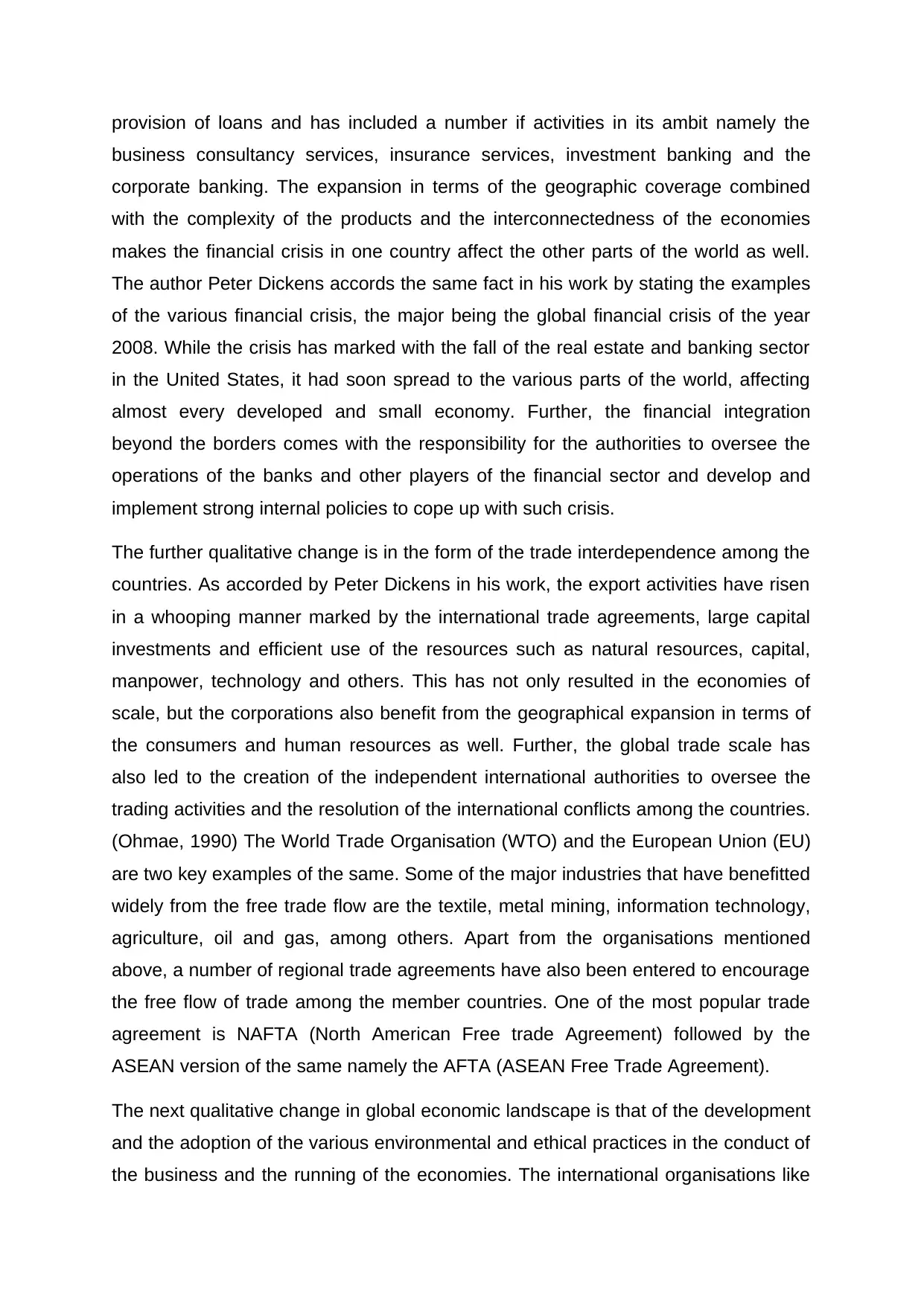
provision of loans and has included a number if activities in its ambit namely the
business consultancy services, insurance services, investment banking and the
corporate banking. The expansion in terms of the geographic coverage combined
with the complexity of the products and the interconnectedness of the economies
makes the financial crisis in one country affect the other parts of the world as well.
The author Peter Dickens accords the same fact in his work by stating the examples
of the various financial crisis, the major being the global financial crisis of the year
2008. While the crisis has marked with the fall of the real estate and banking sector
in the United States, it had soon spread to the various parts of the world, affecting
almost every developed and small economy. Further, the financial integration
beyond the borders comes with the responsibility for the authorities to oversee the
operations of the banks and other players of the financial sector and develop and
implement strong internal policies to cope up with such crisis.
The further qualitative change is in the form of the trade interdependence among the
countries. As accorded by Peter Dickens in his work, the export activities have risen
in a whooping manner marked by the international trade agreements, large capital
investments and efficient use of the resources such as natural resources, capital,
manpower, technology and others. This has not only resulted in the economies of
scale, but the corporations also benefit from the geographical expansion in terms of
the consumers and human resources as well. Further, the global trade scale has
also led to the creation of the independent international authorities to oversee the
trading activities and the resolution of the international conflicts among the countries.
(Ohmae, 1990) The World Trade Organisation (WTO) and the European Union (EU)
are two key examples of the same. Some of the major industries that have benefitted
widely from the free trade flow are the textile, metal mining, information technology,
agriculture, oil and gas, among others. Apart from the organisations mentioned
above, a number of regional trade agreements have also been entered to encourage
the free flow of trade among the member countries. One of the most popular trade
agreement is NAFTA (North American Free trade Agreement) followed by the
ASEAN version of the same namely the AFTA (ASEAN Free Trade Agreement).
The next qualitative change in global economic landscape is that of the development
and the adoption of the various environmental and ethical practices in the conduct of
the business and the running of the economies. The international organisations like
business consultancy services, insurance services, investment banking and the
corporate banking. The expansion in terms of the geographic coverage combined
with the complexity of the products and the interconnectedness of the economies
makes the financial crisis in one country affect the other parts of the world as well.
The author Peter Dickens accords the same fact in his work by stating the examples
of the various financial crisis, the major being the global financial crisis of the year
2008. While the crisis has marked with the fall of the real estate and banking sector
in the United States, it had soon spread to the various parts of the world, affecting
almost every developed and small economy. Further, the financial integration
beyond the borders comes with the responsibility for the authorities to oversee the
operations of the banks and other players of the financial sector and develop and
implement strong internal policies to cope up with such crisis.
The further qualitative change is in the form of the trade interdependence among the
countries. As accorded by Peter Dickens in his work, the export activities have risen
in a whooping manner marked by the international trade agreements, large capital
investments and efficient use of the resources such as natural resources, capital,
manpower, technology and others. This has not only resulted in the economies of
scale, but the corporations also benefit from the geographical expansion in terms of
the consumers and human resources as well. Further, the global trade scale has
also led to the creation of the independent international authorities to oversee the
trading activities and the resolution of the international conflicts among the countries.
(Ohmae, 1990) The World Trade Organisation (WTO) and the European Union (EU)
are two key examples of the same. Some of the major industries that have benefitted
widely from the free trade flow are the textile, metal mining, information technology,
agriculture, oil and gas, among others. Apart from the organisations mentioned
above, a number of regional trade agreements have also been entered to encourage
the free flow of trade among the member countries. One of the most popular trade
agreement is NAFTA (North American Free trade Agreement) followed by the
ASEAN version of the same namely the AFTA (ASEAN Free Trade Agreement).
The next qualitative change in global economic landscape is that of the development
and the adoption of the various environmental and ethical practices in the conduct of
the business and the running of the economies. The international organisations like
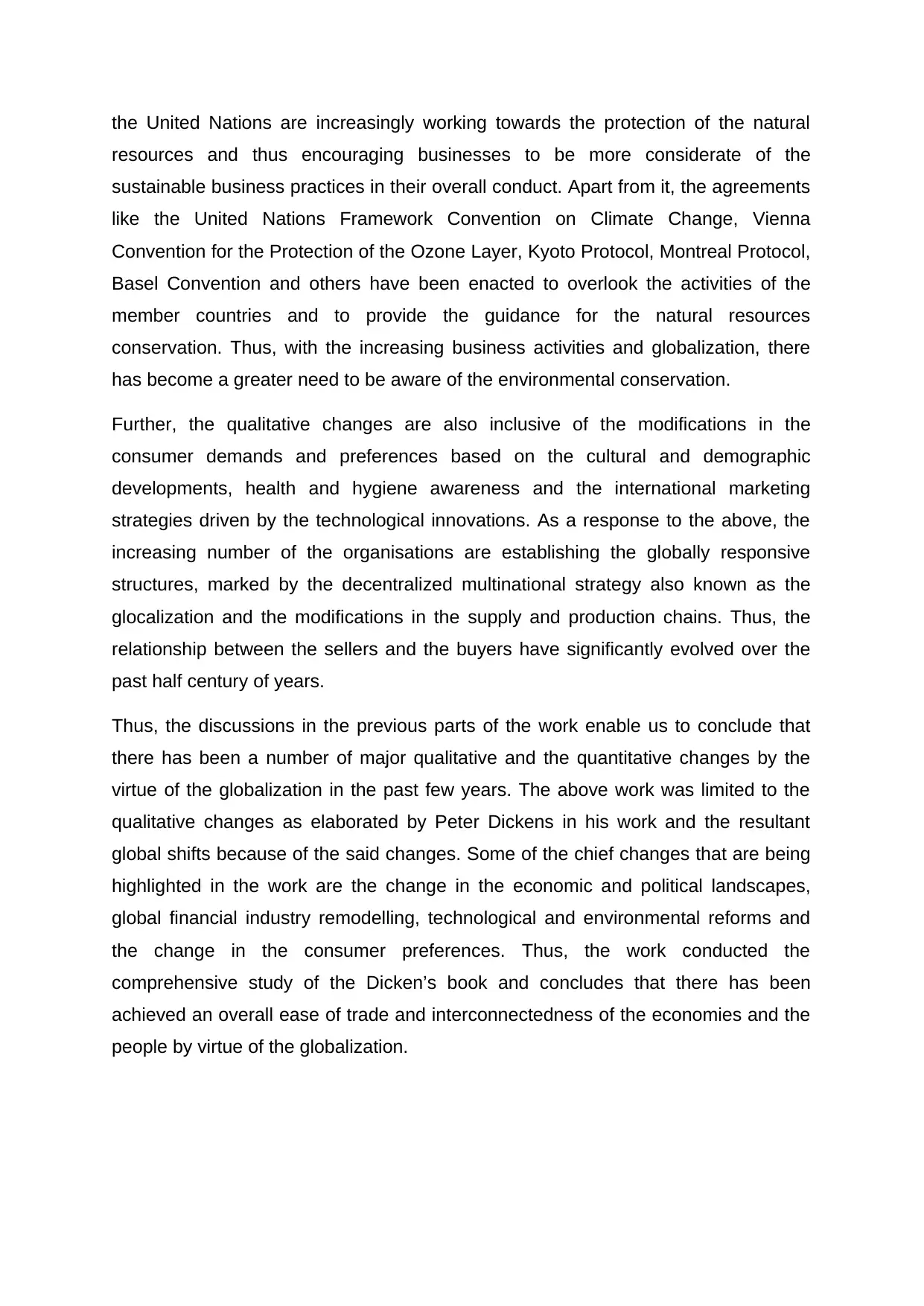
the United Nations are increasingly working towards the protection of the natural
resources and thus encouraging businesses to be more considerate of the
sustainable business practices in their overall conduct. Apart from it, the agreements
like the United Nations Framework Convention on Climate Change, Vienna
Convention for the Protection of the Ozone Layer, Kyoto Protocol, Montreal Protocol,
Basel Convention and others have been enacted to overlook the activities of the
member countries and to provide the guidance for the natural resources
conservation. Thus, with the increasing business activities and globalization, there
has become a greater need to be aware of the environmental conservation.
Further, the qualitative changes are also inclusive of the modifications in the
consumer demands and preferences based on the cultural and demographic
developments, health and hygiene awareness and the international marketing
strategies driven by the technological innovations. As a response to the above, the
increasing number of the organisations are establishing the globally responsive
structures, marked by the decentralized multinational strategy also known as the
glocalization and the modifications in the supply and production chains. Thus, the
relationship between the sellers and the buyers have significantly evolved over the
past half century of years.
Thus, the discussions in the previous parts of the work enable us to conclude that
there has been a number of major qualitative and the quantitative changes by the
virtue of the globalization in the past few years. The above work was limited to the
qualitative changes as elaborated by Peter Dickens in his work and the resultant
global shifts because of the said changes. Some of the chief changes that are being
highlighted in the work are the change in the economic and political landscapes,
global financial industry remodelling, technological and environmental reforms and
the change in the consumer preferences. Thus, the work conducted the
comprehensive study of the Dicken’s book and concludes that there has been
achieved an overall ease of trade and interconnectedness of the economies and the
people by virtue of the globalization.
resources and thus encouraging businesses to be more considerate of the
sustainable business practices in their overall conduct. Apart from it, the agreements
like the United Nations Framework Convention on Climate Change, Vienna
Convention for the Protection of the Ozone Layer, Kyoto Protocol, Montreal Protocol,
Basel Convention and others have been enacted to overlook the activities of the
member countries and to provide the guidance for the natural resources
conservation. Thus, with the increasing business activities and globalization, there
has become a greater need to be aware of the environmental conservation.
Further, the qualitative changes are also inclusive of the modifications in the
consumer demands and preferences based on the cultural and demographic
developments, health and hygiene awareness and the international marketing
strategies driven by the technological innovations. As a response to the above, the
increasing number of the organisations are establishing the globally responsive
structures, marked by the decentralized multinational strategy also known as the
glocalization and the modifications in the supply and production chains. Thus, the
relationship between the sellers and the buyers have significantly evolved over the
past half century of years.
Thus, the discussions in the previous parts of the work enable us to conclude that
there has been a number of major qualitative and the quantitative changes by the
virtue of the globalization in the past few years. The above work was limited to the
qualitative changes as elaborated by Peter Dickens in his work and the resultant
global shifts because of the said changes. Some of the chief changes that are being
highlighted in the work are the change in the economic and political landscapes,
global financial industry remodelling, technological and environmental reforms and
the change in the consumer preferences. Thus, the work conducted the
comprehensive study of the Dicken’s book and concludes that there has been
achieved an overall ease of trade and interconnectedness of the economies and the
people by virtue of the globalization.
Paraphrase This Document
Need a fresh take? Get an instant paraphrase of this document with our AI Paraphraser
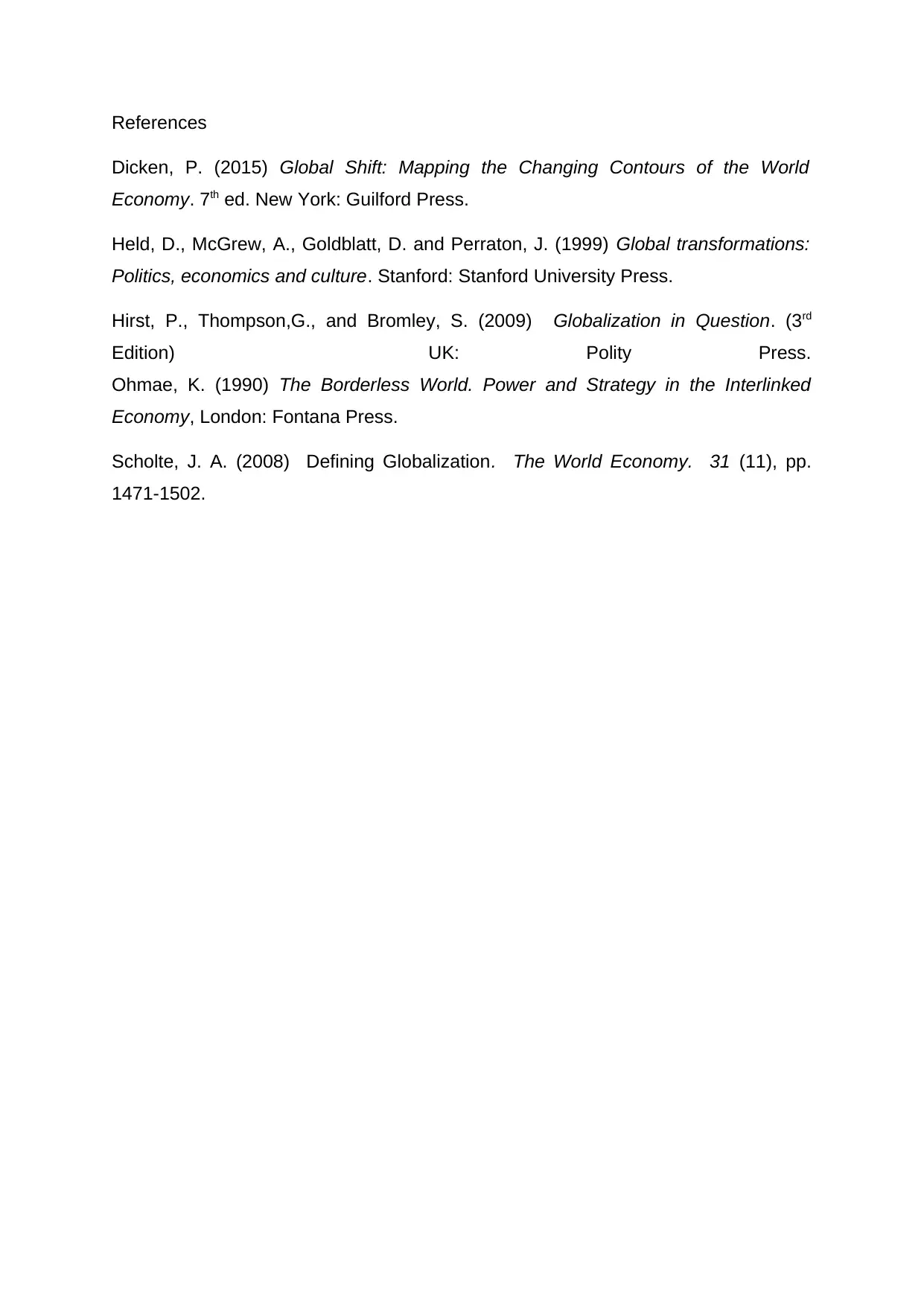
References
Dicken, P. (2015) Global Shift: Mapping the Changing Contours of the World
Economy. 7th ed. New York: Guilford Press.
Held, D., McGrew, A., Goldblatt, D. and Perraton, J. (1999) Global transformations:
Politics, economics and culture. Stanford: Stanford University Press.
Hirst, P., Thompson,G., and Bromley, S. (2009) Globalization in Question. (3rd
Edition) UK: Polity Press.
Ohmae, K. (1990) The Borderless World. Power and Strategy in the Interlinked
Economy, London: Fontana Press.
Scholte, J. A. (2008) Defining Globalization. The World Economy. 31 (11), pp.
1471-1502.
Dicken, P. (2015) Global Shift: Mapping the Changing Contours of the World
Economy. 7th ed. New York: Guilford Press.
Held, D., McGrew, A., Goldblatt, D. and Perraton, J. (1999) Global transformations:
Politics, economics and culture. Stanford: Stanford University Press.
Hirst, P., Thompson,G., and Bromley, S. (2009) Globalization in Question. (3rd
Edition) UK: Polity Press.
Ohmae, K. (1990) The Borderless World. Power and Strategy in the Interlinked
Economy, London: Fontana Press.
Scholte, J. A. (2008) Defining Globalization. The World Economy. 31 (11), pp.
1471-1502.
1 out of 8
Related Documents
Your All-in-One AI-Powered Toolkit for Academic Success.
+13062052269
info@desklib.com
Available 24*7 on WhatsApp / Email
![[object Object]](/_next/static/media/star-bottom.7253800d.svg)
Unlock your academic potential
© 2024 | Zucol Services PVT LTD | All rights reserved.





